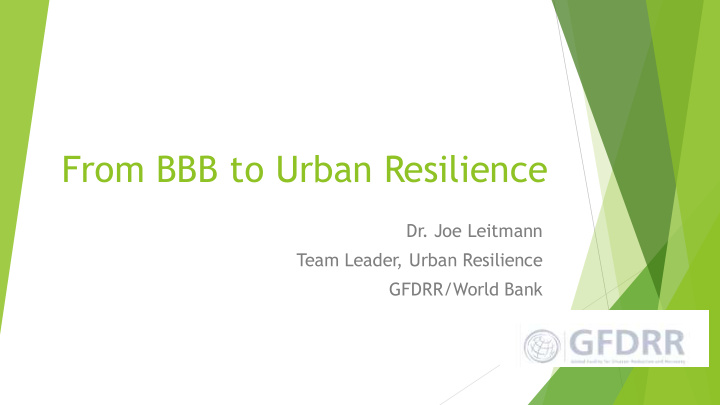



From BBB to Urban Resilience Dr. Joe Leitmann Team Leader , Urban Resilience GFDRR/World Bank
Comparing Reconstruction and Resilience Urban Reconstruction (BBB) Resilience Building Reactive Ex-ante as well as ex-post Often tends to function in silos Considers the urban system as a whole Finishes when structures are rebuilt Continuous and evolving effort Depending on the type of reconstruction Has long term, broad-based economic project, the economic impact can be limited impacts Has limited capacity-building embedded in it Brings adaptive, transformative and absorptive capacities to the city Responds to a single disaster Focus on how the entire city as responds to shocks and stresses Anticipates future risks by building back better Anticipates future risks through mitigation measures in systems, policies and investments
Why focus on urban resilience now? Rapid urbanization 66% of planet will be urbanized by 2050 Over 60% of land projected to become urban by 2030 has yet to be developed One billion new housing units needed by 2060 Growing concentration of economic activity in cities More than 80% of GDP is generated by cities More wealth and productive assets are being exposed to risk Increase in expected losses Urban losses from natural disasters could reach $330 billion per year by 2030 (and this is an underestimate)
City share of GDP & national population
International focus on urban resilience Sendai Framework for Disaster Risk Reduction Integrate hazard & risk into all stages of the urban development cycle UN Sustainable Development Goals and Agenda 2030 SDG 11: Make cities inclusive, safe, resilient and sustainable COP21 Paris Agreement Key role played by urban areas in mitigating emissions and adapting New Urban Agenda Pillar on Environmentally Sustainable and Resilient Urban Development Calls for reduction of vulnerability to hazards and use of risk-based approaches
World Bank Commitments and Program Habitat III commitment: build resilience in 500 vulnerable cities mobilize $500 billion of external financing lift 50 million out of urban poverty City Resilience Program - supports city governments in the design of large- scale investment programs to strengthen resilience Coordinated approach to investment in urban infrastructure across departments that is risk informed Transparent pipeline of well-prepared bankable investment opportunities that link a package of investment opportunities with the range of financial instruments that are most appropriate
Recommend
More recommend